Rimac Gives Croatian Government Lesson on Innovation and Car Industry
As Jasmina Trstenjak/Filip Pavic/Novac writes on the 1st of May, 2019, the Republic of Croatia does have a chance in the car industry, and it can improve its investment portfolio with certain active and proactive measures, open up opportunities for the development of new industries, and not miss this third train, since it has already missed two. Rimac Automobili, the company of one of Croatia's most successful entrepreneurs, Mate Rimac, is more than ready to help if Croatia truly wants to attract the car industry to Croatia. With some work put in to it, it's possible.
The above is one of the key messages given by Mate Rimac, the founder and CEO of Rimac Automobili, which was part of the "Croatia E-mobility Forum", held recently at the Esplanade Hotel in Zagreb and organised by the American Chamber of Commerce (AmCham) and Jutarnji List, during which spoke about "How Croatia can attract the automotive industry".
In his presentation, among other things, analysed the countries that make up Central and Eastern Europe, what the automotive industry brought to them (growth, jobs, contribution to GDP...), which attracted investors, just how Croatia stands in this aspect. He also noted some key trends that are already transforming the car industry.
The automotive industry is completely changing, therefore the use of cars will eventually alter too. People will, at some point, no longer be car owners, they might not even bother to learn to drive, but all this will open up many new doors. Trends show that many cars will become autonomous by 2030, they will all be connected to the internet, more electrification will occur, and the car sharing will become more common. Mate Rimac discussed these points, full of experience as his own company, which has grown into a powerful technology company over the past decade and attracted more investment than all the technology companies in Croatia.
So far, Rimac Automobili has attracted more than 60 million euros in foreign investment, and that's not even counting the European Investment Bank (EIB), which has provided the company with a 30 million euro loan last year. The last investor in Rimac Automobili was no less than Porsche, and that was the very first time Porsche invested in another company.
''We don't want this to be the last investment, but we need to attract investments. Not only because of us, but also because of the state, so that the automotive industry invests in other things in Croatia. This year, a big investor will enter into the structure of our company. It's a 150 million euro investment, and the details on that will be known in a few weeks,'' revealed Rimac. He also emphasised the significance and the power of the branch in which he works - if the automotive industry was a country, it would be the fourth largest in the entire world!
However, rather unsurprisingly, Croatia is lagging behind quite significantly when compared to others, the automotive industry has spread very well across the whole of Europe and Croatia is almost the only exception. Two waves of investment in the region have already been and gone. The first was in the Czech Republic, Poland, Slovenia, the second was in Romania and Slovakia, and now a lot is being invested in neighbouring Serbia.
In the aforementioned countries, the automotive industry started practically from scratch and through the investments of other manufacturers, unassuming little Slovakia has become the largest car maker per capita in the world today. Therefore, in his extensive presentation, Rimac also commented on the way companies choose their sites, what their criteria are, and, when comparing Croatia with other countries, he found that Croatia is not one of the best candidates at all.
''Croatia has thirteen billion dollars worth of exports, with four million people. Slovakia has a million residents and more than 78 billion dollars in exports, out of which, 20 billion dollars of exports are in cars and parts alone. Let's look at some closer neighbors. Slovenia, with more than two million inhabitants, is exporting more than Croatia, and once again, their main export products are cars, and for us, it's wood,'' said Rimac, adding that these countries attracted companies with their favourable labour costs, but also for their talents and good faculties, infrastructure and available capital.
He also noted that Croatia has less than a billion dollars of automotive revenue, while, let's say, the Czech Republic has 41 billion dollars, and it has a strong potential. Thus, Croatia has less than half a percent of GDP, and the Czech Republic accounts for more than five percent of its GDP directly from the automotive industry, which is indeed a very defeating comparison. In the CEE region, investments have occurred thanks to generally cheap labour, and although much of it has well and truly bypassed Croatia, Mate Rimac is certain that there is a way to attract this industry still. Not necessarily with cheaper labour, but also with new opportunities.
''Hundreds of e-car models are coming onto the market. They're developed during a period of four to seven years and what's going on in the labs today will be on the roads within several years. There is a tremendous opportunity since today's share of three percent in sales will jump to 60 percent in the coming decades. That's why there's a lot of investment going on in the automotive industry, in startups and in technology companies. So far, more than 25 billion dollars has been invested through investment ventures, and this is where that industry is heading. There are investments in the development of batteries, in companies that make sensors and the like. The portfolio is bigger than it used to be. Also, there's a lot of heavy investment in development, and budgets are larger,'' noted Rimac.
Rimac also added that not everything is so black, although Croatia is of course late ''to the party'', and is missing out on the opportunity to join the development of the automotive industry by modelling itself on the countries of the CEE region. That industry, he says, is growing steadily, and countries are committed to receiving investments and attracting firms.
''We don't want just any investment, but those that give maximum benefit. But it's not about how much the state will encourage these industries to come. The state must first determine in which direction it wants to go, which industries it has, and then work proactively. England has a great initiative and it does very well because it has a complex program for the automotive industry, it works proactively, runs research centres, test sites... Therefore, proactive measures and projects are needed if there's a desire to go in that direction,'' Rimac said.
The presentation outlined nineteen action measures that the Croatian state should take to accelerate the automotive industry's progress in Croatia.
He mentioned that employees should be allowed to enter into company ownership and there should be a reduction in income taxes on high salaries.
Universities should make sure their programs include more machine learning, artificial intelligence, and electrical engineering.
Universities should employ professors from the STEM sector with scientific reputations, Rimac believes, and invest in equipping faculties and linking universities with actual investors.
In addition, the state should implement tax incentives for R&D-oriented companies, as well as meet with relevant engineers, as well as take a more proactive role in industrial development in co-operation with potential foreign investors.
As far as infrastructure is concerned, it's very important to encourage international contacts with cities that have developed automotive and innovation hubs and additionally invest in the 5G network for all households.
When it comes to specific measures for the automotive industry, among the measures listed above, it's necessary for foreign automotive employees to have temporary housing and job search support provided to the employee's life partner.
Additionally, one of the measures implies the establishment of an international school, where teaching will be conducted in foreign languages.
As far as the infrastructure of the auto industry itself is concerned, Rimac says that the testing of autonomous vehicles on public roads should be legalised, there should be an institute for electric and autonomous vehicles established, as well as an institute for artificial intelligence, as well as centres of competence and innovation hubs.
Make sure to follow our dedicated business page for much more.
Click here for the original article by Jasmina Trstenjak/Filip Pavic for Novac/Jutarnji
Mate Rimac Says Electricity, Sharing, Autonomy Future of Car Industry
ZAGREB, April 30, 2019 - Electric, shared and autonomous - that is the future of cars and the car industry in decades to come, but the question is whether Croatia will be bypassed by an investment wave and whether we will respond on time, said Rimac Automobili owner Mate Rimac at the Croatia E-Mobility Forum, organised by the Jutarnji List daily and the American Chamber of Commerce in Zagreb on Tuesday.
"The future will bring radical changes in the car industry as early as the next 20 years. Cars will be used when necessary, their users will not be their owners, and future generations will probably not even learn how to drive. Close to 80% of cars will be autonomous by 2030 and all cars will be connected to the Internet. Newly-registered electric cars now account for 2% of all cars in Europe, and by 2030 they will account for one-third of all cars, while as many as 90% will be shared by 2030," he said.
Rimac noted that over the past decades the automobile industry had spread across the 'new Europe', the only exception being Croatia.
As a result, Croatia has less than one billion dollars in revenue from the car industry while, for example, the Czech Republic, has 41 billion, he said.
He said that his research showed that contributions on high salaries, such as those in his company, were the highest in Europe, which drives investors away.
"Workers who are paid well bring new value and better jobs for others. Croatia should be a place that will attract the most innovative companies and engineers. The state should decide which investor it wants to attract and proactively work on that," he said.
The head of the American Chamber of Commerce in Croatia, Andrea Doko Jelušić, said that there were an estimated 3.1 million electric vehicles on roads in the world.
She said that the expansion of e-mobility faced three challenges that had to be dealt with: the range of vehicles, infrastructure, and the price, which is defined by expensive batteries.
The head of the Environmental Protection and Energy Efficiency Fund, Dubravko Ponoš, said that this year subsidies for electric vehicles and bicycles amounted to 40 million kuna.
Subsidies will be allocated in the years to come as well, and there will no longer be interruptions in their allocation, he said, noting that the amount of subsidies granted by the Fund was nonetheless ten times smaller than the interest in them.
More news about Mate Rimac can be found in the Business section.
Mate Rimac Employs First Deaf Person to Graduate from FER
Statistics show that about 12,000 deaf people live in the Republic of Croatia, but unfortunately it is rare for them to complete their higher education.
As Ivan Tominac/Poslovni Dnevnik writes on the 14th of April, 2019, Josip Ivanković was born in Čapljina, Bosnia and Herzegovina, but just one year after his birth, he was declared deaf, and this fact was one of his reasons for his relocation to Croatia. His move to Croatia certainly paid off as being the right move, and Josip, despite the diagnosis, managed to develop his speech and the technique of listening. That was, as Josip himself states, a painstaking and long process.
"The situation is that I have to treat speaking Croatian as if I was speaking a foreign language," Josip Ivanković explained.
For four years now, his speech and listening abilities have been being developed at the SUVAG Polyclinic, where Josip learned to speak with vibration, tone amplification, visualisation and by learning anatomy.
"When I learned to pronounce the letter ''r'', I had to touch the vocal chords of the logopad to feel a certain vibration and titration, then I'd lean my hand on my neck to feel the same vibration, so I learned to pronounce the letter ''r'' I learned to pronounce ''ž'' in a similar way, I just put my hand on my head. Generally speaking, the hardest letters to pronounce for the deaf are l,č,ć,đ,dž,lj and nj, and the reason for that is that such letters can't be visually identified. They're explained through the anatomy of the oral cavity, just like a doctor explains the heart's organs, or where the blood enters and where it exits,'' explained Josip.
After the kindergarten era ended, in which he learned the basics of socialisation, it was decided that he should attend a regular school.
This period of schooling, without any curriculum adjustment, he adds, was defined by perseverance, and communicational misunderstandings are, in his words, quite normal and natural.
"The professors made me equal with my peers, and this proved to be a good thing because I learned so much about the world of those who can hear, and I learned how to gather information," said Josip. As stated, statistics show that about 12,000 deaf people live in Croatia, but it is rare for them to complete higher education. Josip was not one of them, and he completed a college which has some very demanding academic requirements for its students.
He enrolled at FER (University of Zagreb, Faculty of Electrical Engineering and Computing), and the likelihood of him completing his studies was slim, yet Josip had different plans for himself.
"At the beginning of the semester, it was very difficult for me to adapt,'' recalled Josip. Before Josip's arrival, professors from Zagreb's FER didn't have any experience in working with people with impaired hearing. At the beginning, he failed several exams, but he didn't let that dampen his spirit, and later he turned to further consultations.
This combination led him to become the very first deaf person to graduated from that college.
"The professors were very approachable, and our relationship was very flexible and adaptable. I will never forget how Professor Brnetić, instead of me asking him, personally invited me to consultations during the holidays and showed me much he cared that I didn't miss anything from the lecture. On the other hand, one professor asked me during consultations why I didn't go to the lectures and asked me how I was learning. I told him that I don't go to the lectures because I can't hear them. I took out a 100-page notebook with my assignments, and the professor was surprised that I did all that without having gone to any lectures. He asked me to lend him that notebook and later I learned that he'd showed my notebook to all of the professors. Believe it or not, a year after when I came to his office, that copy of the notebook was still on his desk,'' Josip stated, recalling his faculty days.
In the end, none of the obstacles he faced along the way turned him away from his goal, and he passed 62 engagements that mostly relied solely on him and his level of dedication. This FER student didn't have to wait around long before a job opportunity came knocking, and it wasn't your regular offer. He started his working life at no less than Rimac Automobili as an Embedded Hardware Engineer. Rimac had no problems with his deafness and offered him a position after his interview.
''At the beginning of the job, I was given a pretty demanding project that I had to complete within a month, which was the length of my trial period, and when the project ended I realised that I was able to complete it and was given the green light to remain with the firm,'' Josip said. The work never stops at Rimac Automobili, and at the moment, Josip is working on a project for the development of electric car chargers.
"Communication skills are the most difficult for me, because I have to invest extra energy into lip reading and that's mentally challenging and difficult. Imagine a situation in which a colleague is referring to professional terms, and I need to decode them with and put them into context in order for me to have any understanding. Imagine switching off your ears, and focusing your eyes on their lips alone.
You aren't likely to understand because they're not using standard words, they're using technical phrases that are difficult to decode and recognise. At the beginning, it was very difficult for me to follow verbal communication and understand the complexity of the project. Of course, since working here I've changed a lot and become much more calm, more focused and concentrated on the small things. The worst thing is when a colleague does not know how to communicate with me properly, and this is where I'm concerned about information which is valuable to the project, and that's an extra effort. Each colleague has his own specific way of speaking and they aren't all the same in communication. With time, I somehow adjusted to them, and they also had to adapt to me, I accepted that this was all normal and there would always be a situation where they couldn't understand, but I'll always ask them to repeat themselves not just twice, but 1000 times!'' concluded Josip.
Make sure to follow our dedicated lifestyle page for much more.
Click here for the original article by Ivan Tominac for Poslovni Dnevnik
Croatia's Bellabeat Received Second Largest Startup Investment
This Croatian startup's beginnings come from Zagreb and it first became well known back in 2014 as the first startup attract a large investment from outside of the Republic of Croatia.
As Bernard Ivezic/Poslovni Dnevnik writes on the 12th of April, 2019, the Croatian startup Bellabeat received an investment from AOL Ventures in the amount of 14.2 million dollars, the equivalent of 12.5 million euros. It's not the biggest investment to be received by a Croatian startup last year, as that remains marked by Porsche's entrance into the co-ownership of Rimac Automobila for 18.7 millions euros, but it remains the second largest. Bellabeat has so far kept this massive investment secret.
AOL is one of the three largest Internet service providers in the United States of America. The company is part of the large Verizon group, which owns a number of popular media outlets including The Huffington Post, Engadget, TechCrunch, and MapQuest. In the group is also the former Yahoo and the AOL Desktop software solution.
Croatia's Bellabeat underwent restructuring half a year before the investment took place, at the end of 2017 and in early 2018. The company then let a number of its employees go. Sandro Mur, co-founder and director of Bellabeat, subsequently announced that he currently has a total of fifty employees and plans to increase this number to seventy. At that time, the Croatian company's focus was on establishing an office across the Atlantic over in New York. The company has developed a range of high-tech products for women, from jewellery to smart water bottles, and plans to deal with artificial intelligence in the health preservation sector.
Five years ago, the founders of Bellabeat, Sandro Mur and Urška Sršen, set the bar very high for Croatian startups. They received a record 4.5 million dollar investment from a number of well-known investors. Among them were actress Jessica Alba, the creator and leading developer of Google Earth, Paul Buchheit, the founder of TechCrunch, Michael Arrington, one of the hundred richest people, Nicolas Berggruen, and one of the most famous investors in the Silicon Valley and one of the very first to have invested in Google and PayPal, Ron Conway.
Make sure to follow our dedicated Made in Croatia and business pages for much more on startups and companies from Croatia, as well as the overall business and investment climate in Croatia.
Click here for the original article by Bernard Ivezic for Poslovni Dnevnik
German President Coming to Croatia, Will Visit Rimac Automobili
The German President Frank-Walter Steinmeier is paying an official two-day visit to the Republic of Croatia from Germany today, the plans include for him to pay a visit to the German and French international school "Eurocampus" and get a taste for the incredible creations of Croatia's most well known entrepreneur, Mate Rimac.
As Poslovni Dnevnik writes on the 21st of March, 2019, upon the invitation of Croatian President Kolinda Grabar-Kitarović, the official visit of the President of the Federal Republic of Germany will begin with a ceremony at the Presidential Office, a friendly tête-à-tête meeting between the two presidents and a bilateral meeting of the official delegations of the Republic of Croatia and the Federal Republic of Germany.
After meeting with President Grabar-Kitarović, President Steinmeier will meet with Croatian Parliament Speaker Gordan Jandroković and go to Zagreb's beautiful Mirogoj cemetary, where he will place a wreath in front of the monument entitled ''Glas hrvatske žrtve - Zid boli'' (The voice of Croatian victims - The wall of pain).
As mentioned, between or after having met with the necessary persons who make up essential parts of the Croatian Government and the Croatian president herself, Germany's Steinmeier will visit the German and French international "Eurocampus" school, as well as the one and only Rimac Automobili which is located in Sveta Nedelja, not too far from the capital city of Zagreb.
Mate Rimac is the undoubtedly the face of modern day Croatian entrepreneurship, echoing the memory of Nikola Tesla from many moons ago. Mate Rimac's Rimac Automobili company was founded back in 2009 with its headquarters located in Sveta Nedelja in Zagreb County, where it remains to this day. The German President's visit to the company's headquarters will continue to send out the message that despite all - you definitely can make it work in Croatia.
Make sure to follow our dedicated politics page for much more.
Mate Rimac Featured in The Economist, as Greyp G6 Launches
March 16, 2019 - International acclaim and successful new product launches, it is all happening for Mate Rimac at the moment, with a feature in The Economist the latest exposure.
It is becoming increasingly hard to keep up with Mate Rimac, and not just because he makes the fastest cars in the world.
It seems not a day goes by without another achievement of media spotlight for the young Croatian entrepreneur, who single-handedly built a car industry in a country where none exists. But while the stereotype is that Rimac Automobili builds cars for the super rich, the core business is technology, as he explained in a major 2016 interview on Croatian television, which was translated by TCN in 2016.
Rimac once again had a spectacular Geneva International Motor Show, and the impact of Rimac Automobili was highlighted in a post on his Facebook page:
What makes us very unique in Geneva (and automotive industry/history in general) is that our products and technologies are represented in many other brand's cars and stands at the show. And not "just" with any parts but with key enables for these cars to even be possible. It is quite incredible that out of the 5 hybrid/electric supercars coming to the market (Aston Martin Valkyrie, Koenigsegg Regera, Pininfarina Batista, Mercedes AMG Project 1, Rimac C_Two), 4 have at least our battery system (some of them much more), which makes Sveta Nedelja the world capital of high-performance hybrid/EV systems. At the same time, there is much more going on behind the scenes - will be an interesting time.
And the industry media has been quick to take notice:
"Rimac is the company that currently holds all the aces. Not Tesla, not Toyota."
Last night's focus was in Zagreb, for the launch of the Greyp G6 smart bike. You can read more about that in this TCN report, or watch the product launch above.
Also named in the top 100 digital champions of Europe by the Financial Times, Mate Rimac also appears in this week's edition of The Economist, Speed King: a Croatian Inventor Says He is Building the World's Fastest Car.
To try and keep up with the Mate Rimac story, follow the dedicated TCN page.
Mate Rimac Introduces New Greyp Smart Bike
A new line of Greyp mountain bikes was presented in Zagreb last night. Unlike with the cars developed by Mate Rimac and his company, the emphasis with the Greyp Bikes is not on speed and power, but on connectivity and smart solutions which should bring about a unique user experience. The technology is the main difference between the new Greyp G6 and the existing mountain bikes, reports Večernji List on March 16, 2019.
Unlike its predecessor, the G6 is a pedelec model, which means that the rider has an electric motor assist, but as soon as he or she stops pedalling, the assistance also ends. The novelty of the new generation of Greyp bikes is their constant internet connectivity through eSIM technology, which opens up new possibilities for bicycle use and riding experience, and allows its owners remote control of specific bicycle functions as well as their monitoring. In addition to all the electronics and software, the G6 is a fully-fledged mountain bike. The frame is made of reinforced carbon fibre composite, with enduro-geometry and 27,5+ tires.
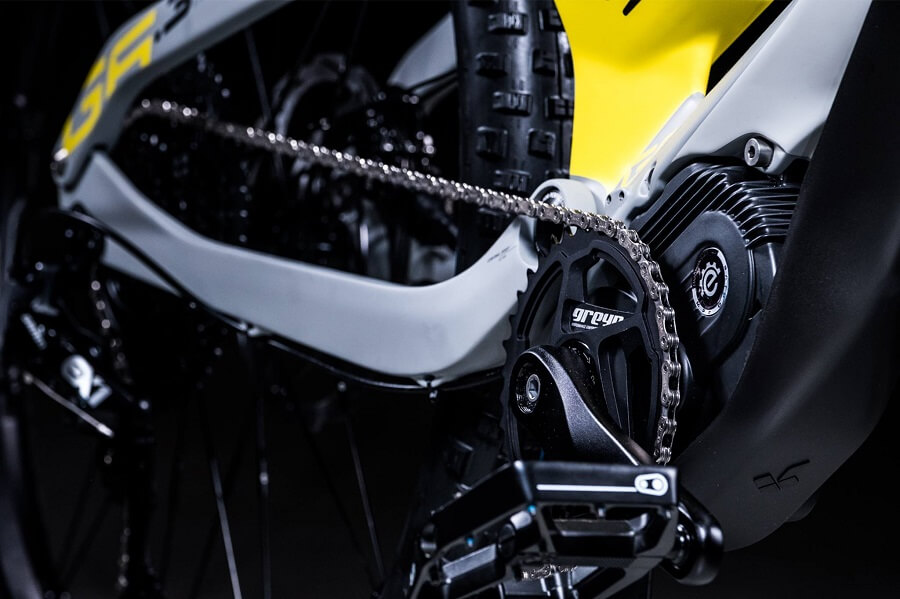
“It took us four years of intensive research, development and testing to create a product that we can present to the public. The features of the system and the technology platform are more important than the product itself. Unlike traditional bicycle companies, instead of equipping a bicycle with electric drive, we have developed a bike around the drive, sensors and constant connectivity to the internet. I believe that we have linked the bicycle and digital components in a unique way, integrated the sensors and cameras, networked the bicycles, developed a mobile app and created a whole new bike experience”, said Mate Rimac.
One of the main features of the new bicycle is the role of the smartphone which becomes the main user interface. Connectivity allows you to send commands to the bike or download images from integrated bicycle cameras even when the bicycle and the user are not in the same location. Cameras capture every situation, and videos and photos can be shared real-time on social networks.
“The whole bike is about connectivity and the Internet, the Internet of Things... There is eSIM, and you do not need a physical SIM card. Each Greyp comes with eSIM, which is just software, and until 2020 everybody will have a free Internet package. We are doing this for our other projects as well, both for our cars and for the cars of other manufacturers, because we are working on connectivity systems for others,” said Rimac.
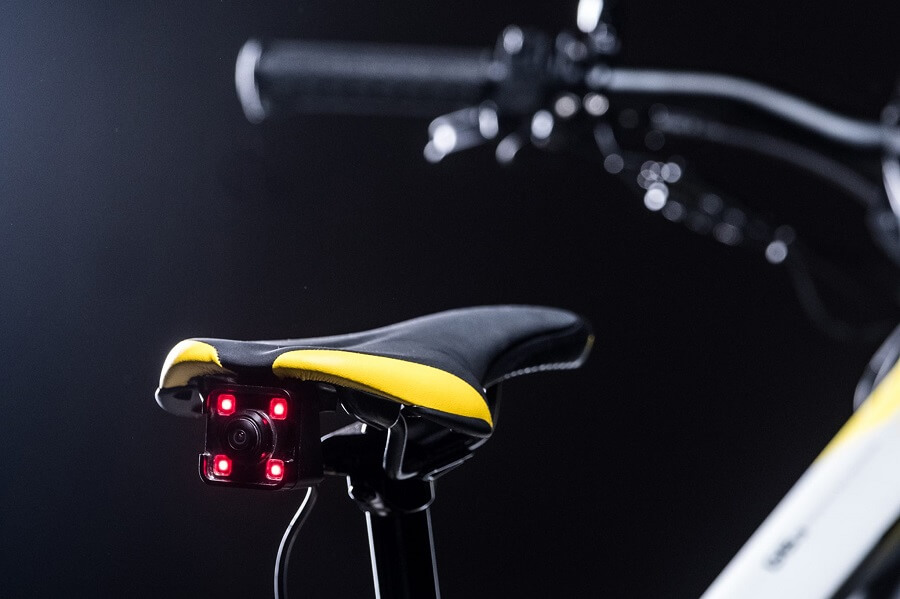
Rimac explained that America, surprisingly, is still a very weak market for electric bicycles. “By far the largest market is Europe, particularly the German-speaking area, so we are focusing there for the time being,” Rimac said, adding that he thinks that Germany will be the largest market for the new bike.
“The main task was to develop the system. And now we want to expand this system to others because it is perhaps even more important to build that user ecosystem than to produce bicycles,” Rimac said.
Rimac also announced that in April the company will move a large part of the production to a location about half an hour away from Sveta Nedelja, where it is now, and that they wanted to remain in the area.
Translated from Večernji List (reported by Zoran Vitas).
More news about Mate Rimac can be found in the Business section.
Rimac to Present Improved C_Two in Geneva
After the C_Two premiere at the Geneva international motor show last year, Rimac Automobili will this year present the final look of the C_Two model, whose first prototypes are already in production. In Geneva, Rimac will also show the early indications of the final performance characteristics of the electric drive which will be subjected to hundreds of tests during the certification phase, reports Index.hr on March 5, 2019.
“With the testing program launched early this year, Rimac Automobili is continuing to work hard on developing the C_Two model. New technologies are being introduced, and the model is undergoing hundreds of tests and procedures to meet all of the initial goals and global approval standards," said the Croatian manufacturer of electric vehicles on its website, announcing the participation in this year's Geneva motor show.
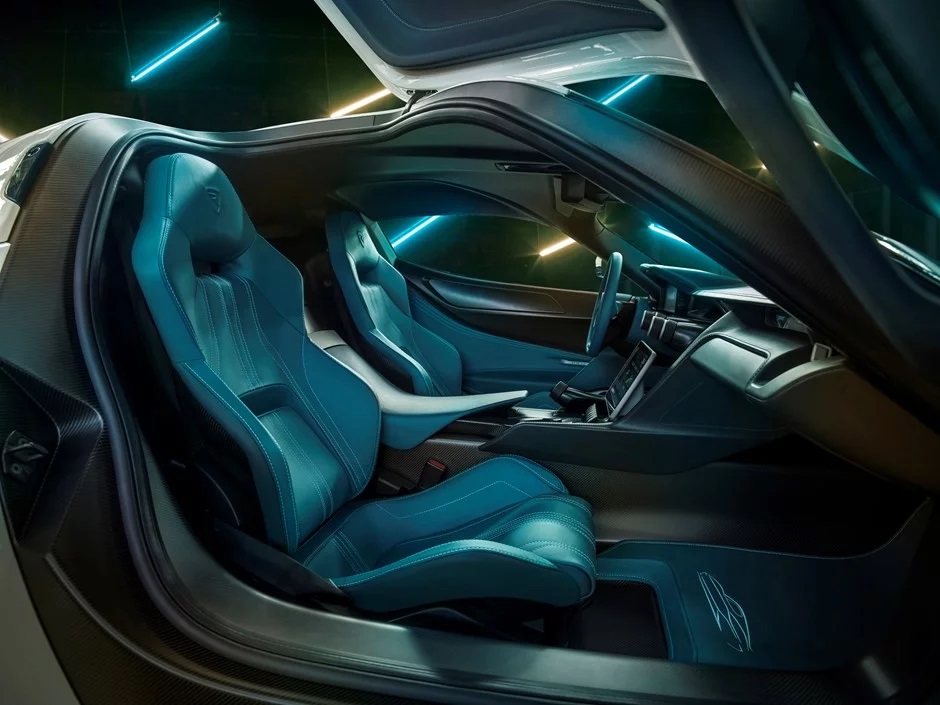
As announced, Rimac C_Two is the world's most powerful electric hyper-car, which demonstrates the expertise of the technology leader from Sveta Nedjelja near Zagreb in high-performance vehicle systems. The C_Two has a four-engine drive system with a total of 1914 horsepower and a torque of 2300 Nm. The acceleration from 0 to 100 km/h takes just 1.85 seconds, and it can reach the speed of 300 km/h in 11.8 seconds. A 120-kWh battery allows for a range of 550 km according to the WLTP standard (650 km according to the NEDC standard).
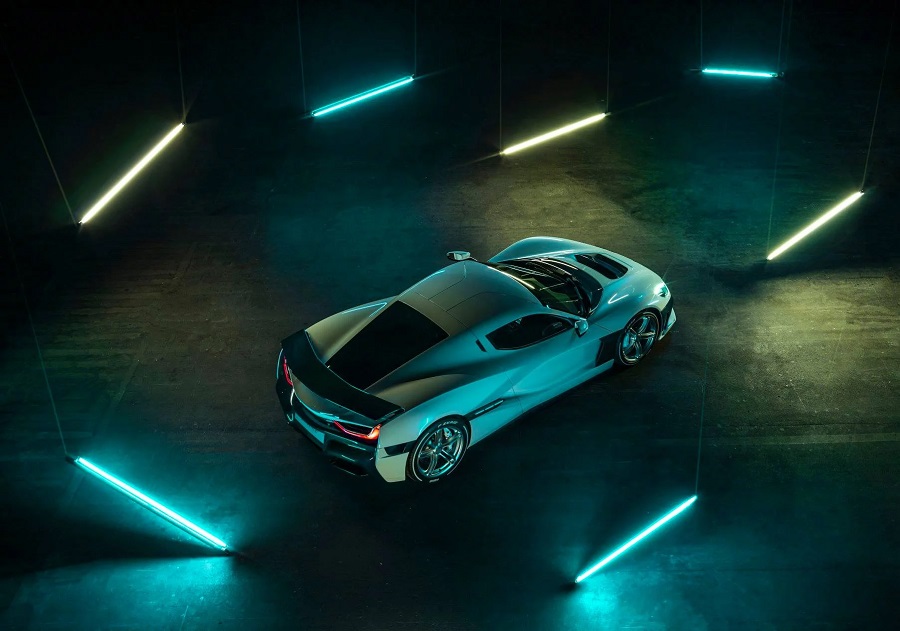
These figures have stunned the world, but with the latest efforts, the C_Two will be even more advanced. Prototypes are in the production phase, and the C_Two will soon get its final shape. In 2020, its performance characteristics will be seen on the streets all over the world, and C_Two will demonstrate how far (and how quickly) the electrical technology went into the future.
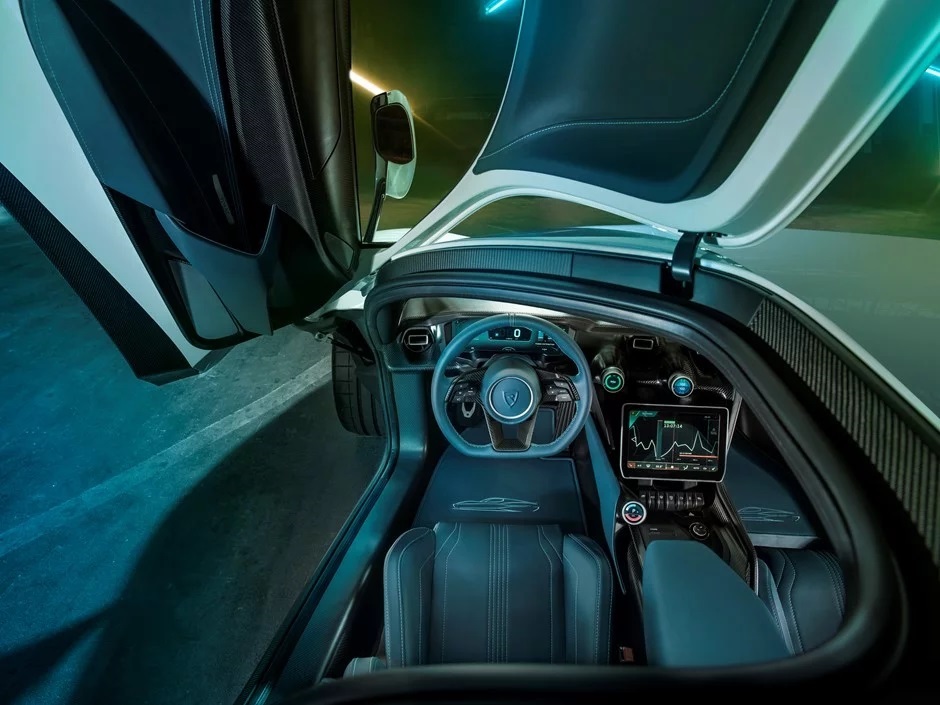
The C_Two model which will be presented at the 2019 Geneva Motor Show has been made in the galactic white colour with deep blue carbon fibre elements. The interior is hand-made and specially designed, with carbon fibre which complements blue leather and contrasting seams. This specification reveals an elegant but also exciting C_Two model profile.
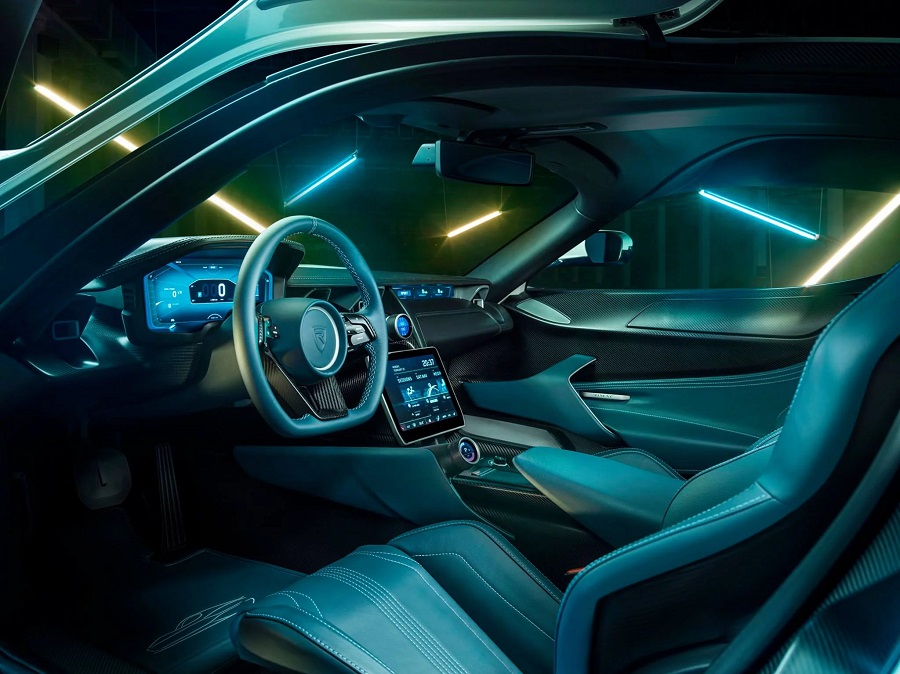
"The designing, engineering and production of key electrification systems for high-performance vehicles is still the mission of Rimac Automobili. During 2018, the company that can no longer be called an automotive startup has grown to twice its previous size and now supplies with its batteries, drives, hardware and software solutions its numerous partners in the automotive industry, powering some of the most extreme performance electric vehicles and hybrid electric hyper-cars on the market. The goal is always to offer innovative technologies to the high-performance market, starting with the crown jewel – the Rimac C_Two model,” concludes the company.
More news about Rimac Automobili can be found in the Business section.
Translated from Index.hr.
Rimac Automobili Receives Loan for Capacity Development and Expansion
A huge cash loan from the European Investment Bank for Mate Rimac's company Rimac Automobili has been signed and sealed.
Mate Rimac is without a doubt the face of one of Croatia's most inspiring entrepreneurial stories ever. Success doesn't come easily in Croatia, and while many prefer to complain about that face or simply go off and seek it elsewhere, only to realise that nowhere is quite as easy to navigate as you're told, people like Mate Rimac keep on fighting and make things happen.
Croatia is full of talent and it spills out onto all possible fields, from sport to business to invention and innovation, this little country of approximately four million people has it all. Despite being the home of people like Luka Modric and Mate Rimac, what Croatia doesn't have, however, is a set of state authorities who want to make life more simple for that talent to not only remain within the country, but to manage to develop and flourish here. Just like what was stated previously, Mate Rimac and Rimac Automobili have conquered those barriers, meaning others can, too.
As Poslovni Dnevnik writes on the 7th of December, 2018, the vice president of the European Investment Bank (EIB), Dario Scannapieco, has signed a contract with Privredna banka Zagreb for a loan guarantee for Rimac Automobili, totalling an enormous 30 million euro.
The European Investment Bank and Rimac Automobili then signed the very welcome loan of 30 million euro for research purposes, as well as for the company's capacity development and expansion in Sveta Nedjelja.
In addition to the huge loan provided to Rimac Automobili, another loan worth 25 million euro loan was given to innovative small and medium-sized companies.
Make sure to follow our dedicated Made in Croatia and business pages for more information on Rimac Automobili, other Croatian companies, products and services, as well as all you need to know about the business and investment climate in Croatia.
Rimac Automobili Releases Photos of C_Two Aerodynamic Testing
Croatia’s Rimac Automobili has published on its Facebook page impressive photos of the C_Two aerodynamic testing in an air tunnel, reports Index.hr on November 24, 2018.
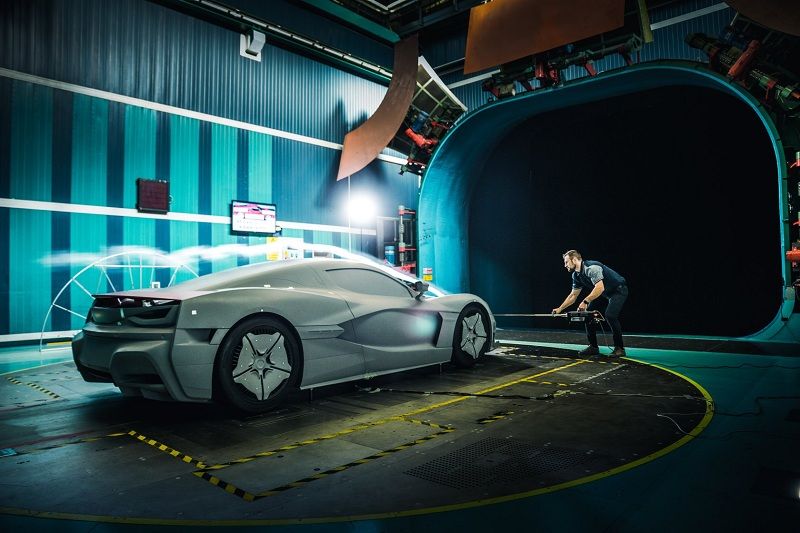
“This is a sneak peek into the Rimac C_Two wind tunnel test.
This is a full-scale model built specifically for the wind tunnel test with fully functional active aero components, realistic suspension and brakes, fans, the realistic pressure drop across the radiator cores and the rotating wheels.
It enabled us to test the relevant parts quickly and compare to the CFD results.
The testing was done before releasing the tooling into production, this way any potential changes can still be implemented in the production car.
More soon... Stay tuned,” wrote the company on its Facebook page.
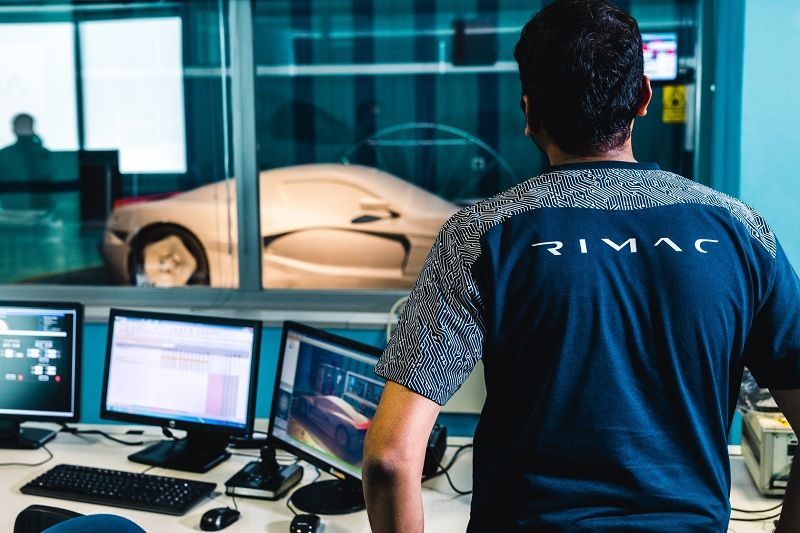
Croatian entrepreneur Mate Rimac and his company have been going from strength to strength in recent years. Just recently, Mate Rimac was named one of the top 100 digital champions of Europe and has given an in-depth interview to Financial Times. Two weeks ago, the company announced it was creating additional 100 jobs in Croatia. Mate Rimac was also named one of the Innovators under 35 by the MIT Technology Review. In September, Rimac Automobili announced a partnership with Pininfarina on a production of a new electric car.
This autumn, the company’s new model C_Two was presented in Zagreb, where it delighted all those who saw it, just like it did a little bit earlier in Los Angeles, where another presentation was organised.
Rimac even worked on the famous Jaguar which was featured heavily during the wedding of British Prince Harry and Meghan Markle in May this year.
Mate Rimac has proven that it is possible to succeed in Croatia, despite the business environment which is far from what it should be.
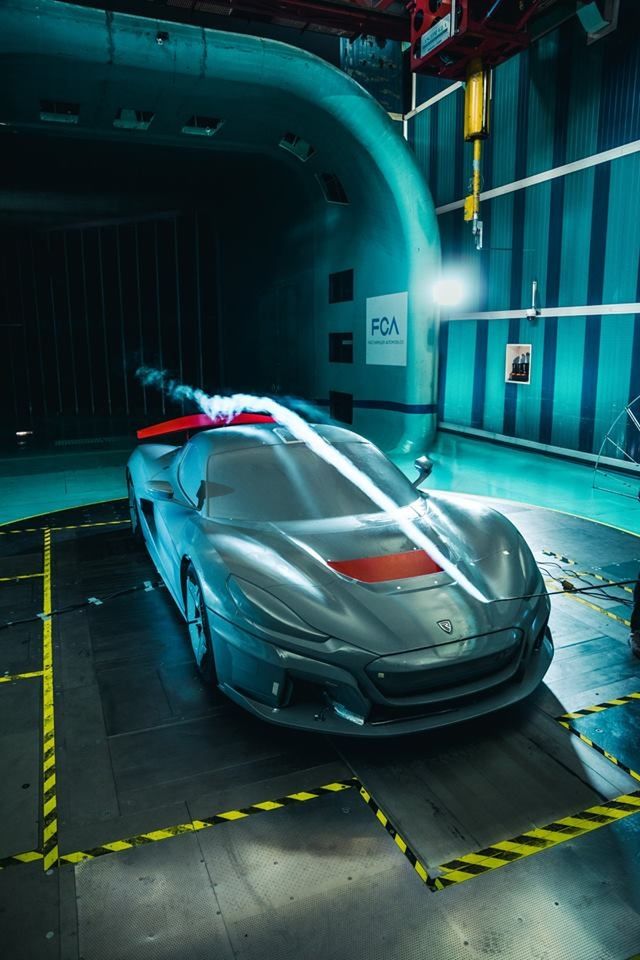
For more on Mate Rimac and Rimac Automobili, one of Croatia's fastest growing and best technology companies, click here.


